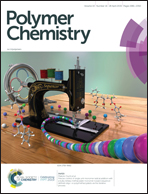Broad spectrum absorption and low-voltage electrochromic operation from indacenodithieno[3,2-b]thiophene-based copolymers†
Abstract
Electrochromic performance of conjugated polymers has quickly become an important design factor in a variety of applications. There is still significant need to develop highly stable materials with high optical contrast, desired colour switching and fast kinetics. Here, poly[indacenodithieno[3,2-b]thiophene-2,8-diyl] (PIDTT) is introduced as a new type of electrochromic polymer exhibiting a narrow absorption band, excellent electrochemical stability and fast colour switching kinetics between vibrant red (peak maximum at ∼550 nm) and transparent (peak maximum at ∼920 nm) within a low potential range of 0–0.8 V. To widen the spectral coverage of the well-functioning PIDTT over the entire visible range, a modified donor–acceptor approach is used by incorporating three different donor–acceptor–donor (DAD) segments into an indacenodithieno[3,2-b]thiophene (IDTT) based polymer backbone, so as to obtain three different alternating copolymers. This design motif is further rationalized by the maintained electrochemical stability of the new copolymers, and their full colour switching between black and transparent down to an ultra-low potential range of 0–0.6 V.
![Graphical abstract: Broad spectrum absorption and low-voltage electrochromic operation from indacenodithieno[3,2-b]thiophene-based copolymers](/en/Image/Get?imageInfo.ImageType=GA&imageInfo.ImageIdentifier.ManuscriptID=C8PY01787E&imageInfo.ImageIdentifier.Year=2019)


 Please wait while we load your content...
Please wait while we load your content...